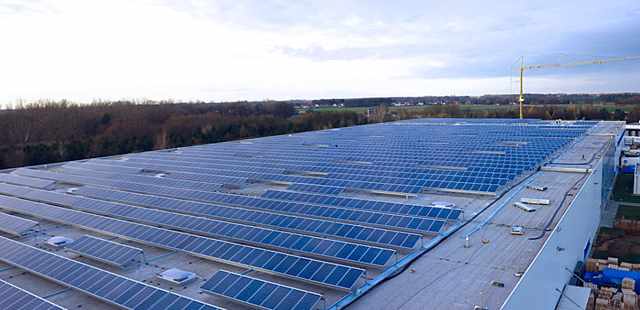U.S. solar firms installed more than 2 gigawatts of photovoltaic capacity between April and June, a 43 percent increase over the same period in 2015 and the fifth largest quarterly growth in the industry’s history, according to data released this morning by GTM Research and the Solar Energy Industries Association.
But the 2,051 megawatts of new PV capacity, coupled with the 1,986 MW of solar completions recorded from January to March, is a mere appetizer on the full 2016 menu of solar projects expected to be completed by year’s end, experts say.
CHECK OUT: China Fights Water Pollution, Bans Paper Mills and Oil Refineries
Industry data on solar arrays under construction or expected to be finished by December show solar PV will add 13.9 GW of new power generation this year, a 90 percent increase over 2015’s figure of 7.3 GW (ClimateWire, Feb. 22).
“There’s no question. It’s an eye-popping figure,” said Cory Honeyman, associate director of U.S. solar research for GTM, which compiles industry performance data in conjunction with SEIA. “We’re seeing the beginning of an unprecedented wave of growth that will occur throughout the remainder of 2016, specifically within the utility PV segment.”
LOOK: H&M Unveils Sustainable and Affordable Wedding Dress Line
Moreover, 2017 and 2018 could be equally robust years for solar PV as many projects that were initially slated for a 2016 completion have been extended to 2017 and beyond, Honeyman said. Many of those projects are large solar farms being pursued by electric utilities or independent developers that will sell output from the projects under power purchase agreements.
According to the new report, utility-scale solar installations accounted for 53 percent of all PV installed during the first half of this year. But residential solar is also breaking records and passing milestones, with the 1 millionth residential rooftop solar system installed earlier this year, GTM said.
MORE: Costa Rica Has Been Powered Only By Renewable Energy For 122 Days
And while some traditionally strong solar markets like California have experienced slower growth in recent years, that trend has been offset by rising investment and development activity in other states such as Utah, Texas and North Carolina, officials said.
“Solar works in all 50 states, and this report proves that what many would consider nontraditional markets are now firmly a part of the clean energy movement,” said Tom Kimbis, SEIA’s interim president.
CHECK OUT: IKEA UK To Start Selling Solar Panels in New ‘Solar Shops’
“While it took us 40 years to hit 1 million U.S. solar installations, we’re expected to hit 2 million within the next two years,” Kimbis added.
By 2021, 20 states are expected to host at least 1 GW of total operating solar PV, officials said, while 30 states will add more than 100 MW of annual solar capacity.
The second-quarter performance report, combined with the robust projections for 2017 and 2018, reflects the solar industry’s phenomenal success at capturing a bigger share of the power generation market during a period of profound upheaval due to pressing economic and environmental concerns, most notably the decline in coal-fired power generation.
MORE: Historic Route 66 to Become Solar Roadways First Highway Project
But the industry is not without its growing pains, some of which have been laid bare in Nevada, where up to 15,000 industry leaders, solar enthusiasts and other observers are gathering this week.
Among the key issues being discussed is the very future of SEIA, the nation’s largest solar trade organization. Just days before the SPI conference, a group of SEIA members released a letter criticizing the group’s board for being too Washington-centric and for being over-represented by utility solar interests (EnergyWire, Sept. 8).
RELATED: California Breaks Solar Record, Generates Enough Electricity for 6 Million Homes
Senior SEIA representatives rebutted those criticisms, noting that the organization works to represent all interests within the solar industry, including utilities, developers, manufacturers and installers.
“As the fastest growing new source of energy, which will double its installations in the next two years, solar has moved from being a niche energy technology to a mainstream one,” SEIA board Chairman Nat Kreamer wrote in an open letter to the group’s members. “This transition brings new policy opportunities and challenges for the U.S. solar industry and its national association.”




















